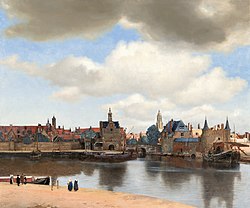Oil paint: Difference between revisions
re-wrote a little bit, added reference |
m →History: spelling, punctuation |
||
| Line 3: | Line 3: | ||
== History == |
== History == |
||
The slow-drying properties of organic oils were commonly known to early painters. However, the difficulty in aquiring and working the materials meant that they were rarely used. As the public |
The slow-drying properties of organic oils were commonly known to early painters. However, the difficulty in aquiring and working the materials meant that they were rarely used. As the public preference for realism increased, however, the quick-drying [[tempera]] paints became insufficient. [[Flemish]] artists used mixed tempura and oil painting during the [[1400s]], but by the [[1600s]] easel painting in pure oils was common, using much the same techniques and materials found today. |
||
== Carrier == |
== Carrier == |
||
Revision as of 09:06, 11 January 2006

Oil paint is a type of slow-drying paint consisting of small pigment particles suspended in any light carrier other than water. Oil paints have been used in England as early as the 13th century for simple decoration[1], but were not widely adopted for artisic purposes until the 15th century. The most common modern application of oil paint is domestic, where its hard-wearing properties and luminous colours make it desirable both interior and exterior use.
History
The slow-drying properties of organic oils were commonly known to early painters. However, the difficulty in aquiring and working the materials meant that they were rarely used. As the public preference for realism increased, however, the quick-drying tempera paints became insufficient. Flemish artists used mixed tempura and oil painting during the 1400s, but by the 1600s easel painting in pure oils was common, using much the same techniques and materials found today.
Carrier
When exposed to air, vegetable oils do not undergo the save evaporative process that water does. Instead, they oxidize into into a dry solid. Depending upon the source, this process can be very slow, and it this property which gives oil paints their unique characteristics.
This earliest and still most commonly used vehicle is linseed oil, made from the seed of the flax plant. The seeds are crushed and the oil extracted. Modern processes use heat or steam in order to produce a larger volume of oil, but cold-pressed oils are generally considered superior for artistic use[2]. Other sources of carrier oils exist. poppies, walnuts, and soya beans, are often used as a substitute for the relatively expensive linseed.
Once the oil is extracted additives are sometimes used improve its chemical porperties. in this manner the paint can be made to dry more quickly if that is desired, or to have varying levels gloss. Modern oils paints can have vey complex chemical structures due to this, for effects such resistance to UV or a suede like appearance.
Pigment
The colour of oil paint derives from the small particles mixed with the carrier. Common pigment types include lead, cadmium, and earth types. Synthetic pigments are also now available. Natural pigments have the advantage of being well understood through centuries of use but synthetics have a greatly increased the spectrum available, and many are tested well for their lightfastness.
Usage
The main disadvantage of oils paints is the relative complexity of use when compared to acrylic paint or tempera. The carrier is usually highly resistant to water and requires some sort of solvent such as turpentine or benzene to clean up. These are toxic must be handled with care. The pigments may also be dangerous. Lead is known to cause cancer with prolonged exposure and cadmium can cause cancer with prolonged inhalation. Both the carriers and the materials used to clean them are also highly flammable. Paper or rags soaked in pure linseed oil are known to spontaneously ignite.
References
General
- Mayer, Ralph. The Artist's Handbook of Materials and Techniques Viking Adult; 5th revised and updated edition, 1991. ISBN 0670837016
Footnotes
- ^ Charles Eastlake, Materials for a History of Oil Painting, Longman, Longman, Brown, Green, and Longman, 1847.
- ^ H. Gluck, The Imprermanences of Painting is Relation to Artist's Materials, Journal of the Royal Society of Arts, Volume CXII 1964
